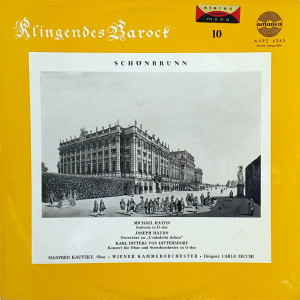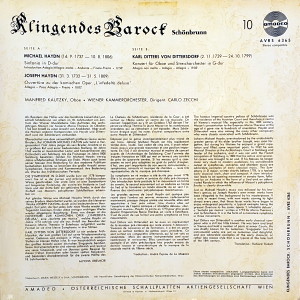 |
1 LP -
Amadeo AVRS 6365
|
 |
|
| SCHÖNBRUNN -
Klingendes Barock - 10 |
|
|
|
|
|
| Michael Haydn
(14.9.1737 - 10.8.1806) |
|
|
| Sinfonia in D-dur |
12' 50" |
A1 |
| - Introduction:
Adagio/Allegro molto · Andante ·
Finale: Presto |
|
|
|
|
|
Joseph Haydn
(31.3.1732 - 31.5.1809)
|
|
|
| Ouvertüre zu der
Komischen Oper "L'Infedeltà
delusa" |
10' 02" |
A2 |
| -
Allegro · Poco adagio · Presto |
|
|
|
|
|
Karl Ditters von
Dittersdorf (2.11.1739 - 24.10.1799)
|
|
|
| Konzert für Oboe
und Streichorchester in G-dur |
19' 03" |
B1 |
| - Allegro non
molto · Adagio · Allegro |
|
|
|
|
|
| Manfred
Klautzky, Oboe |
|
WIENER
KAMMERORCHESTER / Carlo
Zecchi, Dirigent
|
|
|
|
|
|
Luogo
e data di registrazione |
|
- |
|
|
Registrazione:
live / studio |
|
studio |
|
|
Edizione LP |
|
AMADEO
- AVRS 6365 - (1 lp) - durata 41'
55" - (p) 1966 - Analogico |
|
|
Altre edizioni
LP |
|
MUSICAL
HERITAGE SOCIETY - MHS 639 - (1
lp) |
|
|
Prima Edizione
CD |
|
- |
|
|
Note |
|
Stereo
compatibile
|
|
|
|
|
The
famous Imperial
country palace of
Schönbrunn
was the residence of
the Austrian Court
and therefore a
centre of Vienna's
musical life,
especially in the 18th
century, Mozart's
presentation to the
Empress Maria
Theresia at the age
of 6 gave rise to
hundreds of
anecdotes. Haydn and
Dittersdorf were
also among the many
other composers who
were closely
associated with Schönbrunn.
Johann Michael
Haydn, overshadowed
by the undoubtedly
greater genius of
his elder brother
Joseph, was soon
forgotten, but
during his lifetime
he enjoyed a great
reputation and
filled some
important posts. In
1762 he was Musical
Director at the
Archbishop's Court
in Salzburg and
leader of the
orchestra, and it
was not until the
French occupation of
Salzburg in 1800
that his active and
successful career
was brought to an
end. If
his Masses no longer
mean very much to
modern audiences,
his considerable
output of
symphonies,
concertos and
chamber music are
admirable examples
of early classical
music. The Symphony
in D maior, written
shortly before 1778,
is a typical early
classical work,
short and compact. A
slow introduction
leads to an opening
movement in sonata
form,
followed by an
Andante in the form
of a Lied and an
abbreviated Rondo in
which the influence
of Mozart’s
polyphonic finales
is clearly
discernible.
Just as Michael
Haydn’s music was
eclipsed by his
brother's genius, so
Joseph Haydn`s own
minor works have
been relegated to
the background by
his masterpieces. It
is only in recent
times, with new
works coming to
light almost every
year, that these
lesser works have
begun to enioy
widespread
popularity, a
typical example
being the present
Overture to the
comic opera
"L'infedeltà
delusa", a "burletta
per musica" written
in 1773 for Maria
Theresia`s visit to
Esterhaza. It is in
the form of a
miniature symphony
in three movements.
Karl Ditters von
Dittersdorf is
another early
classical composer
who is still too
little known. He was
born and bred in
Vienna and held a
number of posts at
minor Courts. He was
chiefly known for
his numerous
"Singspiele" but his
instrumental works
are just as numerous
and delightful, and
are admirable
examples of the
early classical, or
rather late rococo
style that is so
typical of the later
half of the l8th
century.
Alfons
Übelhör
(Translation;
Richard Rickett)
|
|

